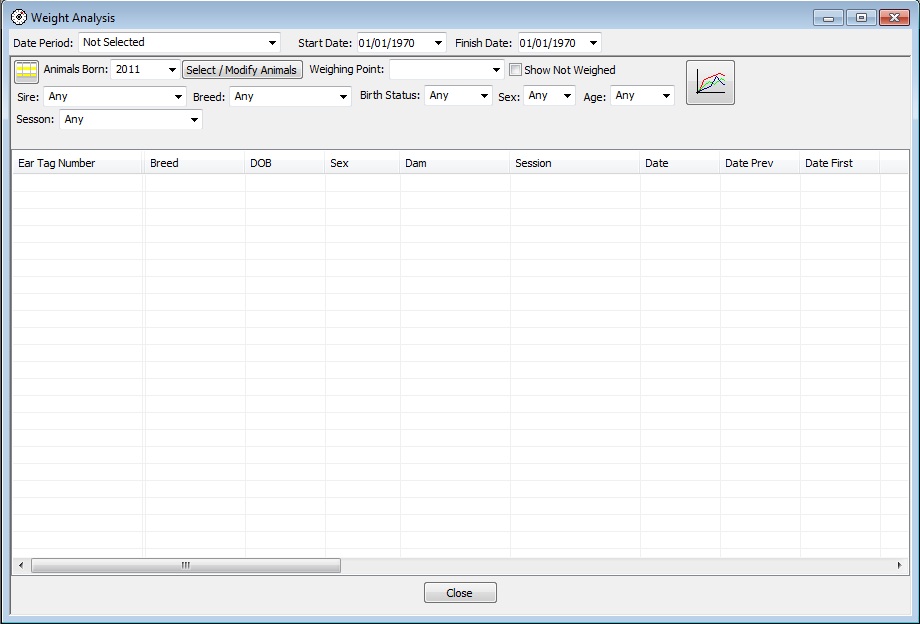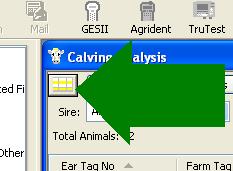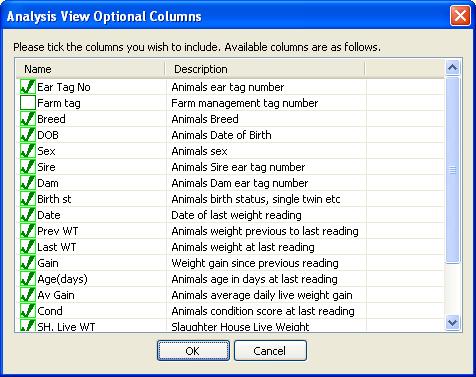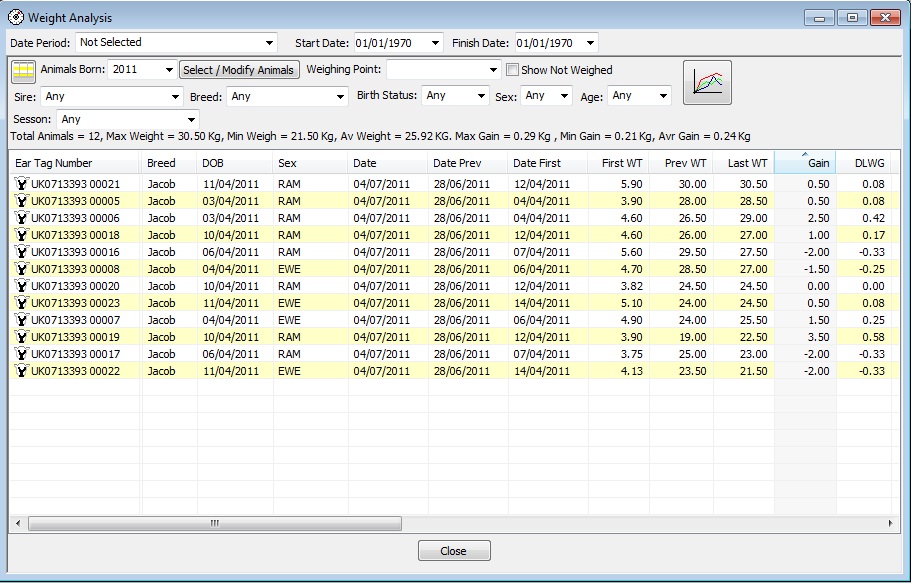Farm IT Help - Livestock Weights, Recording and Analysis
Livestock Weights, Recording and Analysis
Whether you are a commercial or pedigree breeder weighing you stock is of course a critical part of performance management and health care. FarmIT 3000 provides not only the fascility to record weight data,
but flexiable routine for data collection and specialised tools for analysis, reporting and export.
Weight collection and Recording
With even a small number of animals manual entry of weight data has to be considered the very last resort.
So Farm IT provides specific interfaces for data collection via the FarmIT Mobile
software and tools for import or download from weigh heads, specifically the Tru-Test range.
Please see the section on Tru-Test devices for details. Generic import routines
also allow the import of data from CSV files (comma separated text files). This
are available on the main window file menu.
FarmIT 3000 Direct Manual Entry
You may enter weights on an individual basis by selecting the animal record
and clicking on the <new> entry on the weights tab, however this is very
time consuming if you are adding more than one or two record. (See Animal Weight Records)
You may also enter weights using the Bulk Weight Entry view which allows you
to select the animals then simply enter the new weight into the list and the
create all the new weight records when you click 'OK'. (See Bulk Weight Entry)
Finally you may import weights (from a file produced by another program or
spread sheet etc) using the import tools available on the file menu. (See Importing Weight Records)
Weight Analysis Tools for Live Weight, Dead Weight and Weighing Points
The weight analysis tools are split into three distinct tools, live weight, dead weight and weighing point analysis.
Live weight focuses on weight gains, including first weight, previous weight and
last weight. It is primary aim to review on farm progress of your animals from
weighing session to weighing session, so you may identify poor performance of
individuals, groups etc. Dead weight focuses on first on farm weight, last
weight and dead weight, including carcass grading and purchase and sale prices.
Its main aim is to provide analysis of cost margins along side weight, This is
specifically good for store animals where a specific purchase price has been
recorded. Weighing point analysis provides detailed analysis at specific growth
stages, for example 100 or 200 days weight in cattle or 56 days (8 week Weights)
in sheep. The weighing points analysis uses the collected weight data to
calculate adjusted weights at the target date, for example converting a weight
taken at 96 days to 100 day weight by adding on the 4 days of daily live weight
gain. This analysis tool is specifically useful for comparing animals for
breeding perposes and selection of Sires and Dams.
Live Weight Analysis
The weight analysis view is available from the 'Beef Stock' or 'Sheep'
menu's and displays the following form, which in this case is for selected
sheep.

Unlike the fixed reports the view is customizable and you may select the
columns you wish to have listed by clicking the report columns button. You may
modify the select the columns you want to display by clicking on the column
selection button in the top left hand corner of the form.

This dispalys the available columns from which you may choose which columns
to display. Simply tick or untick the column name.

You may select animals using either the animal selection button or by animals
born in a particular year. This is very usefull when wishing to analyse lambs
born in a particular year.
Once the animals are selected you may refine your selection by using the drop
down options, Sire, Breed, Birth Status, and Sex.
The display will automatically update with the animals
matching the criteria and calculate an average weight and weight gain which will be displayed in the
grey area above where the animals are listed.
You may deselect an individual animal by simply right clicking on the ear tag number in the left hand column. It
will disappear as soon as the right mouse button is clicked with no further
warning.
Double click an ear tag number in the left hand column to open the
animals details.
Animals are sorted within the list by their weight
gain. The weight displayed is always the last recorded weight and the average
gain is based on the weight and the animals age producing the average gain per
week. This gain is taken from a base of zero to the weight when they were last
measured. It is not strictly therefore the weight they have gained since birth.

If you now wish to graph the animal weights
all you need do is click the graph button  (top right of the window).
(top right of the window).
You may also print the displayed data or export the data to
Microsoft Excel for further analysis.
See
Weight Graphs .
Fixed Reports
Fixed reports are also provided under the reports menu and provide a wide range of reports which may be printed or exported. These include specifically designed reports for sending data to SIGNET or SIL
Exporting Weight Data
Weight data may be exported in either an excell format or text format from all reports and analysis tools. Simply click on the main window File menu and then the export option to export the data.